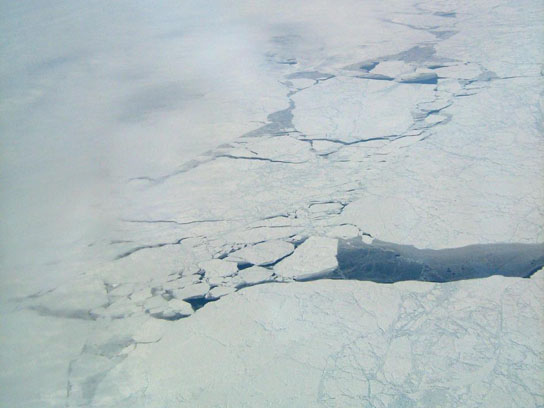
A new airborne study with NASA contributions measured surprising levels of the potent greenhouse gas methane coming from cracks in Arctic sea ice and areas of partial sea ice cover. This image was taken over the Arctic Ocean at a latitude of approximately 71 degrees North on April 15, 2010. Credit: NASA/JPL
As scientists continue to research and monitor greenhouse gas emissions, a new source of methane gas has appeared from cracks in Arctic sea ice. Conducted as part of the HIAPER Pole-to-Pole Observations (HIPPO) airborne campaign, this study was published in Nature Geoscience and describes how the team found increased levels of methane gas while flying at low altitudes over cracks in Arctic sea ice.
The fragile and rapidly changing Arctic region is home to large reservoirs of methane, a potent greenhouse gas. As Earth’s climate warms, the methane, frozen in reservoirs stored in Arctic tundra soils or marine sediments, is vulnerable to being released into the atmosphere, where it can add to global warming. Now a multi-institutional study by Eric Kort of NASA’s Jet Propulsion Laboratory, Pasadena, California, has uncovered a surprising and potentially important new source of Arctic methane: the ocean itself.
Kort, a JPL postdoctoral scholar affiliated with the Keck Institute of Space Studies at the California Institute of Technology in Pasadena, led the analysis while he was a student at Harvard University, Cambridge, Mass. The study was conducted as part of the HIAPER Pole-to-Pole Observations (HIPPO) airborne campaign, which flew a specially instrumented National Science Foundation (NSF)/National Center for Atmospheric Research (NCAR) Gulfstream V aircraft over the Pacific Ocean from nearly pole to pole, collecting atmospheric measurements from Earth’s surface to an altitude of 8.7 miles (14 kilometers). The campaign, primarily funded by NSF with additional funding from NCAR, NASA and the National Oceanic and Atmospheric Administration, was designed to improve our understanding of where greenhouse gases are originating and being stored in the Earth system.
During five HIPPO flights over the Arctic from 2009 to 2010, Kort’s team observed increased methane levels while flying at low altitudes over the remote Arctic Ocean, north of the Chukchi and Beaufort Seas. The methane level was about one-half percent larger than normal background levels.
But where was the methane coming from? The team detected no carbon monoxide in the atmosphere that would point to possible contributions from human combustion activities. In addition, based on the time of year, location and nature of the emissions, it was extremely unlikely the methane was coming from high-latitude wetlands or geologic reservoirs.
By comparing locations of the enhanced methane levels with airborne measurements of carbon monoxide, water vapor and ozone, they pinpointed a source: the ocean surface, through cracks in Arctic sea ice and areas of partial sea ice cover. The cracks expose open Arctic seawater, allowing the ocean to interact with the air, and methane in the surface waters to escape into the atmosphere. The team detected no enhanced methane levels when flying over areas of solid ice.
Kort said previous studies by others had measured high concentrations of methane in Arctic surface waters, but before now no one had predicted that these enhanced levels of ocean methane would find their way to the overlying atmosphere.
So how is the methane being produced? The scientists aren’t yet sure, but Kort hinted biological production from living things in Arctic surface waters may be a likely culprit. “It’s possible that as large areas of sea ice melt and expose more ocean water, methane production may increase, leading to larger methane emissions,” he said. He said future studies will be needed to understand the enhanced methane levels and associated emission processes and to measure their total contribution to overall Arctic methane levels.
“While the methane levels we detected weren’t particularly large, the potential source region, the Arctic Ocean, is vast, so our finding could represent a noticeable new global source of methane,” he added. “As Arctic sea ice cover continues to decline in a warming climate, this source of methane may well increase. It’s important that we recognize the potential contribution from this source of methane to avoid falsely interpreting any changes observed in Arctic methane levels in the future.”
Reference: “Atmospheric observations of Arctic Ocean methane emissions up to 82° north” by E. A. Kort, S. C. Wofsy, B. C. Daube, M. Diao, J. W. Elkins, R. S. Gao, E. J. Hintsa, D. F. Hurst, R. Jimenez, F. L. Moore, J. R. Spackman and M. A. Zondlo, 22 April 2012, Nature Geoscience.
DOI: 10.1038/ngeo1452
The study, published April 22 in Nature Geoscience, included participation from JPL and Caltech; NSF, Arlington, Va.; NOAA’s Earth System Research Laboratory, Boulder, Colo.; the University of Colorado’s Cooperative Institute for Research in Environmental Sciences, Boulder; Harvard University, Cambridge, Mass.; Princeton University, Princeton, New Jersey; Universidad Nacional de Colombia, Bogota, Colombia; and Science and Technology Corporation, Boulder, Colo. JPL is a division of Caltech.

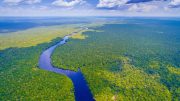


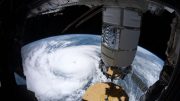
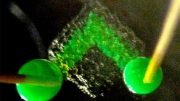


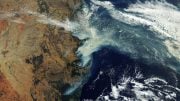
Perhaps large scale hydrothermal flux leads to more methane emissions and higher thermal load at variable depths as well as lower pH values. It was recently shown that we have underestimated the amount of water that is subducted. We have made big assumptions about the distribution, density, and characters of these features.
What We Have Now, Is a Broken Up and New Jet Stream, Centered From Greenlands 20 feet of Sea Level Rise of Ice and Snow
Moving Over 17 degrees from the Center of the Arctic. To Greenland, an Is Now Being Pierced, and Lobed
Because of Mantle Methane, Methane Hydrates, Pingoes, Perma Frost, Fracking, all emitting Methane NOW ! and are Polluting an Emitting over 40–50 Billion Toxic Tons of Carbon each year Globally.
All this Hot Gas has Melted the Arctic and Will Bring a Blue Arctic in 2019 an It Has Pierced the Jet Stream in to Lobes, Moving it Over 17 degrees from The Center of The Arctic.
The Hot Gas Fueled with the Insane Arctic, Greenland, and Antarctic Ice Melts.
Has Roared its Global Warming Frontal Lobes with Record Setting Temperatures and Record Setting Snow, and Record Setting Rain.
These Methane, and Carbon Molecules Have Roared Their Increased Water Vapor and Global Warming Gases, That will Set Record Heat, Record Snow, Until Greenland is 1/2 melted.
Then Just Record Rain, and Record Heat Year After Fossil Fuel Nuclear Radiated Sea Level Rising Over 220 Feet Year.
We are already Locked in to 10C. Temp Rise Even If We Stopped Emitting Now
Methane has a 10 year lag time an Carbon has 30–50 Year Lag time in Reaching its Full Molecule Potential in Holding Heat Mass
Methane has 130 Times More Heat Mass in the Molecule in First Ten years
Then 86 Times More Heat Mass per Molecule over 20 years
Then 34 Times More Heat Mass per Molecule over next 80 Years Than Carbon
Four Geological Formations Spewing and Venting Methane Now In The Arctic and one Venting Along The Washington Oregon Coast
Perma Frost Melting
Methane Hydrates
Mantle Methane From Isostatic Rebounding of Greenlands North American Plate
“Pingoes — Started in 2005 Finger Size Blow Holes, Now 300 Foot Wide Methane Blow Holes Increasing in Number and Size, in Siberia, Canada, an the Euro-Asian Plate Pingoes and Under Water Pingoes
“Pingos preceded blow-outs
Researchers have now examined satellite images of northern Siberian from a few years back and looked at the area where the explosions occurred. They found that the year before the huge crater appeared, there were large pingos in the same place.
Pingos are found in the arctic and are usually raised hills, like a giant pimple, with a core of ice.
In this case, however, the pingos must have been filled with gas in the form of ice, bound up with water in gas hydrates and permafrost.
Russian scientists have now mapped 7,000 gas-filled pingos that are poking through the thawing permafrost, visible in satellite images that illustrate how the pingos form and grow, published in The Siberian Times.” Siw Ellen Jakobsen
Methane Burp Or Pingoe Popping Pimple
and at some point, like Natalia Shakhov, Guy Mcpherson, and Kevin Hester point out, we are going to experience a Methane blow out in the Arctic, from Mantle Methane, Perma-Frost, Methane Hydrates, Pingoes.
The Methane has been telling us, it is going to blow since 2005 by Maria Shakhov, what was a finger size blow whole in 2005 is now a 200–300 ft. wide blow hole called Pingoes 2015
And their increasing in number and size in Siberia, North American Plate, and on the Euro-Asian Plate